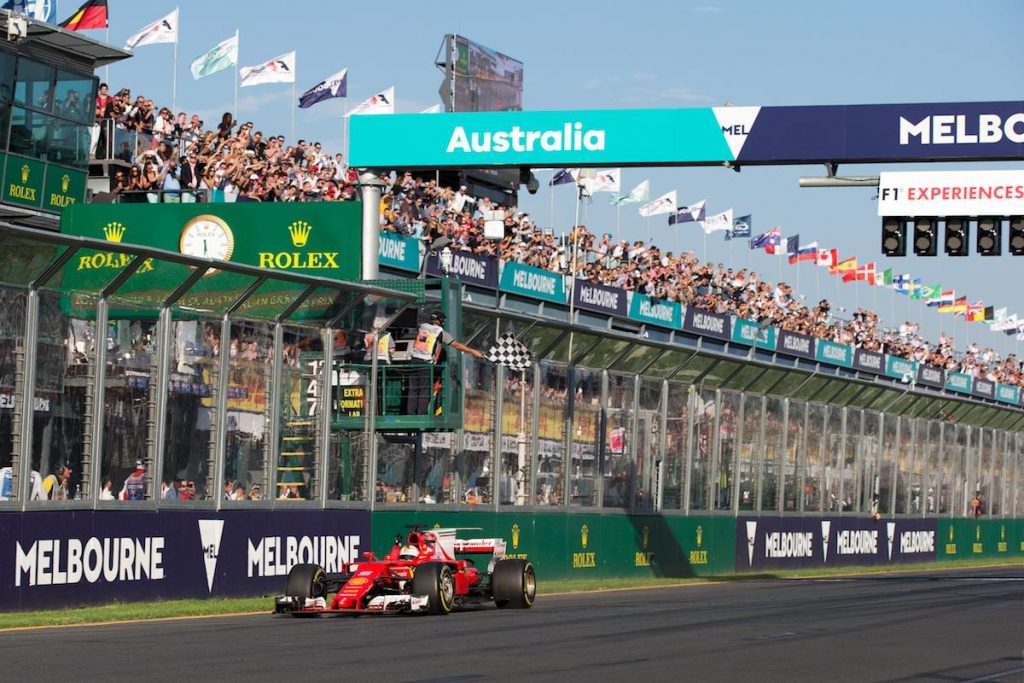
Learn about the history of the Australian Formula 1 Grand Prix, which has been held in Melbourne since 1996, more often than not as the first race of the new F1 season.
Melbourne began hosting the Australian Grand Prix at the Melbourne Grand Prix Circuit (Albert Park) in 1996, taking over from Adelaide, which hosted the race from 1985-1995. Albert Park is a historic venue which held two non-championship Australian Grand Prix races in 1953 and 1956 on a shorter, anti-clockwise track.
For the majority of the year, Albert Park is a popular local recreational space with walking trails, picnic areas and sports facilities. The temporary circuit is assembled around six weeks before race weekend and then disassembled again four weeks after the race.
In recent years, typical attendance over the weekend in Australia has been around 400,000 spectators, with a crowd in excess of 100,000 on race day, making it one of the best attended races on the current F1 calendar.
In 2022, on F1’s return to Albert Park after an enforced two-year absence due to the coronavirus pandemic, the attendance figure exceeded 400,000. It was the best-attended Australian Grand Prix since the event moved to Melbourne in 1996 – but that figure has since been broken twice. In 2023, the Australian Grand Prix ended the year as the second-best attended race of the season, with a 4-day attendance figure of 444,631. Attendance grew by another 8,000 in 2024 to over 450,000, making it one of the best-attended F1 race weekends in history.


There is a friendly atmosphere and the multicultural population of Melbourne provides a great welcome for traveling fans. The Australians do such a good job of organizing the race weekend that representatives from Australia have helped organizers from newer races on the calendar to plan their own Grands Prix.
The race costs taxpayers in Victoria approximately $50m AUD per annum, which has been a source of some controversy for some time, despite the tourism revenue and global promotion the city enjoys from the race.
After signing a two-year contract extension in 2019 to keep Albert Park on the F1 calendar until 2025, Australian Grand Prix organisers signed a longer-term deal in June 2022. The new deal secured the future of the event in Melbourne until at least 2035. The agreement was extended by a further two years, to 2037, just six months later.
The Australian Grand Prix is expected to return to the season-opening slot on the calendar for at least four seasons before its latest contract expires in 2037. It has been confirmed by the local government that the race will not open the season in 2024.
In 2023, Formula 2 and Formula 3 joined Albert Park’s support race schedule for the first time, giving trackside spectators even more on-track action to watch.
Australian Grand Prix Home Race Heroes
Australian drivers have had plenty of success in Formula 1. Their drivers have amassed 43 wins, 35 pole positions and 130 podium finishes, along with four world titles (three for Jack Brabham and one for Alan Jones). Read More: The Top 10 Australian Formula 1 Drivers
An Australian driver has never finished on the podium at their home race since the Australian Grand Prix became a round of the World Championship in 1985. The best result from an Australian at Albert Park is 4th place. Mark Webber was the first driver to do this, in 2012. Daniel Ricciardo finished second in 2014, but was later disqualified. He went on to finish fourth in the Australian Grand Prix in 2016 and 2018. Oscar Piastri joined the club of Australian drivers finishing fourth in their home race at the 2024 Australian Grand Prix.
In 2023, McLaren rookie Piastri followed in the footsteps of his manager Mark Webber by scoring his maiden Formula 1 points on home soil. He did so with an eighth place finish. Read more about Australia’s Home Race Heroes.

Australian Grand Prix: Did you know?
- Michael Schumacher is the most successful driver at Albert Park, scoring four wins (2000, 2001, 2002, 2004).
- The lowest grid slot a Grand Prix at Albert Park has been won from is 11th. David Coulthard achieved this in 2003, with what would be his final victory in F1.
- Danish driver Kevin Magnussen finished second in Australia in 2014 on his debut. It remains his best result, and his only podium finish, to date. The race also marked McLaren’s last podium result for over five years.
- Magnussen isn’t the only driver to have taken a podium finish on debut at Albert Park. Jacques Villeneuve and Lewis Hamilton did the same in 1996 and 2007 respectively. Villeneuve also took pole position at the inaugural event.
- The 2007 Australian Grand Prix is the only time, other than the first F1 race, where every driver on the podium was making their maiden appearance for the team with whom they were competing. Kimi Raikkonen won on his Ferrari debut, while Fernando Alonso and Lewis Hamilton both made their first podium appearances for McLaren.
- It takes an estimated 290,000 man hours to assemble the circuit every year.
- Lewis Hamilton took pole at the Australian Grand Prix in every season between 2014 and 2019, but converted only one of those pole positions (2015) into race victory.
- Eddie Irvine is the only driver to have celebrated his maiden F1 victory at this track. He won his first Grand Prix with Ferrari here in 1999.
- The 2012 Australian Grand Prix was the first F1 race to feature six active World Champions competing in it.

Memorable Moments at the Australian Grand Prix
1996: Brundle Flies at Turn 3
The first race of the modern era at Albert Park got off to a chaotic start. Martin Brundle launched his Jordan car through the air after hitting the back of David Coulthard’s McLaren at Turn 3 in a spectacular accident. Incredibly, Brundle escaped unhurt and was even able to take the restart of the Grand Prix in the team’s spare car. The corner has become renowned for large accidents, with Fernando Alonso also infamously colliding there with Esteban Gutierrez’s Haas in 2016. Alonso was forced to miss the following race as a result of his injuries in the dramatic crash.
2002:Webber’s Minardi Debut
When Mark Webber made his F1 debut with Minardi in 2002, it’s fair to say that expectations weren’t particularly high for the Australian’s performance in his first race. Webber became the first Australian to start his home race since 1994, qualifying in eighteenth. By the closing stages of the Grand Prix, Webber had made his way up to fifth. The Minardi was struggling, having lost top gear and with Mika Salo closing in. Webber held on to take an impressive fifth place finish in his maiden Grand Prix, scoring Minardi’s first points since 1999. He and team boss Paul Stoddart even had their own podium celebrations in front of the enthusiastic partisan crowd!
2008: An Afternoon of Mayhem
The 2008 Australian Grand Prix was a chaotic one, with just seven drivers reaching the end of the race. A multitude of incidents saw five drivers end their races on the first lap, while Felipe Massa and David Coulthard had a sizeable coming together at Turn 1 before the race had reached half-distance. The largest crash of the afternoon was for Timo Glock as he ran wide and broke his suspension, sending his Toyota car airborne. Rubens Barrichello was disqualified from the race having left the pit-lane when the red light was showing. The incident occurred after the Brazilian had a bad pit-stop, in which he left his pit-box with the fuel-hose still attached. Despite all of the incidents around him, Lewis Hamilton stayed calm to take victory, while Nico Rosberg secured his first podium finish.
2009: Brawn GP’s Rise from the Ashes
As Honda announced their withdrawal from Formula 1 at the end of 2008, Jenson Button and Rubens Barrichello were left without a drive. Luckily for them, and the workforce at the Brackley factory, Ross Brawn stepped in to save the team. Brawn GP turned up to the Australian Grand Prix having set impressive lap times in Winter Testing. Their pace was confirmed as Button took pole and went on to win the race, with his team-mate finishing as runner-up. It was the first win for a team making their debut since Mercedes in 1954.
Australian Grand Prix Facts
| Circuit Name | Melbourne Grand Prix Circuit (Albert Park) |
| Track Length | 5.278km (16 turns) |
| Race Distance | 58 laps (306.124 km) |
| Lap Record | 1:19.813, Charles Leclerc (Ferrari), 2024 |
| 2024 Result | 1st Carlos Sainz (Ferrari) 1:20:26.843 |
| 2nd Charles Leclerc (Ferrari) +2.366s | |
| 3rd Lando Norris (McLaren) +5.904s |
Get the Inside Line
For the latest event news, subscribe to our mailing list for the 2025 Australian Grand Prix (March 13-16)






Charles Leclerc set the race lap record in 2022, not 1996 (he wasn’t born until 97) ;) And important to note, he set it on the new revised faster layout. Prior to 2022, it was M.Schumacher at a 1:24.x back in the early 2000’s
Thanks for spotting the error, the post is now updated!